The forests of Kentucky are home to a diverse range of tree species, including hardwoods and pines. These forests provide many benefits to the state’s residents, including clean air and water, wildlife habitat, and wood products.
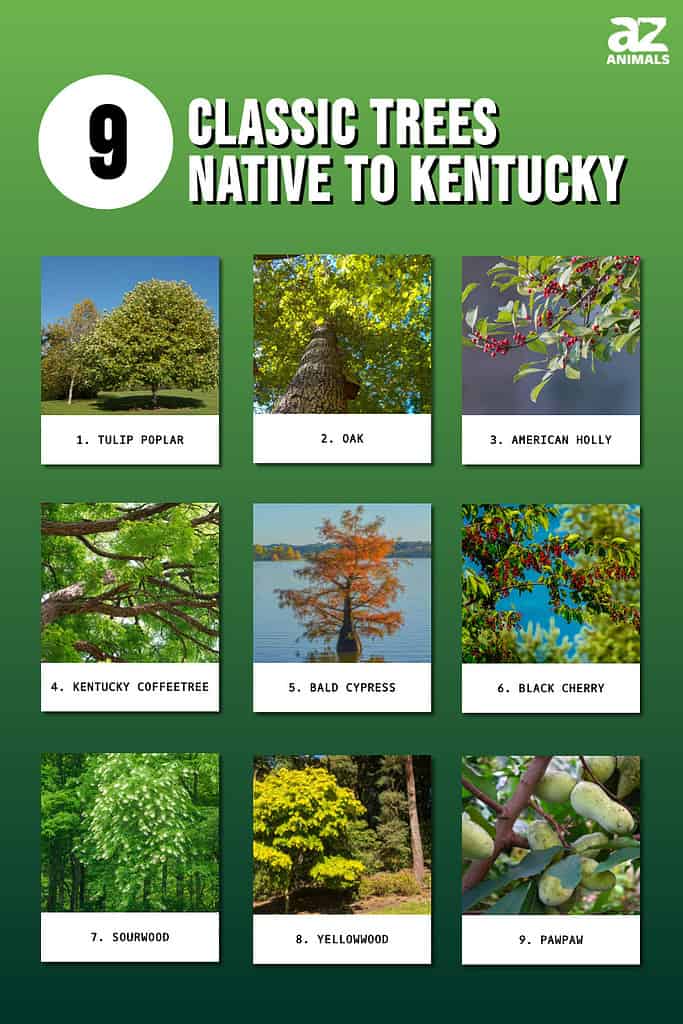
Kentucky is home to a wide variety of hardwood trees, second only to Florida in the United States. Trees native to Kentucky include oak, maple, hickory, ash, poplar, and sycamore. Each of these species can provide unique benefits such as shade and beauty for your property or providing habitats for local wildlife. Additionally, many of these trees are valuable lumber sources harvested throughout the state. With so many different tree varieties available in Kentucky, it’s easy to find something that will fit perfectly into any landscape or project you may have planned!
The twelve-point-four million acres of forests in Kentucky are a sight to behold. They play an integral role in the environment, providing habitats for wildlife and serving as carbon sinks that mitigate climate change effects. Of this forestland, 88 percent is privately owned, making conservation efforts even more important. Seventy-five percent of these woodlands comprise oak-hickory forest types due to their hardiness and fast growth rate. Red maple trees are also abundant, making up 12.2 percent of all trees in Kentucky. Red maples provide food sources for many species of birds and other animals. Below are some of our favorite trees native to Kentucky.
1. Tulip Poplar
The tulip poplar is a deciduous tree found in all parts of Kentucky. It has an attractive pyramidal shape and grows to heights of up to 150 feet. In the spring, its greenish-yellow and orange flowers appear, shaped like tulips, after which it was named. The leaves are bright green during the summer months, turning golden yellow in the fall before dropping off for winter dormancy.
The samara seeds produced by the tree are a popular snack for many wildlife species throughout the region. As such, this native species serves as both an ornamental addition to yards and gardens and provides valuable habitat for local wildlife populations. The tulip poplar is currently designated as Kentucky’s state tree due to its prevalence across the state and its impressive growth rate.
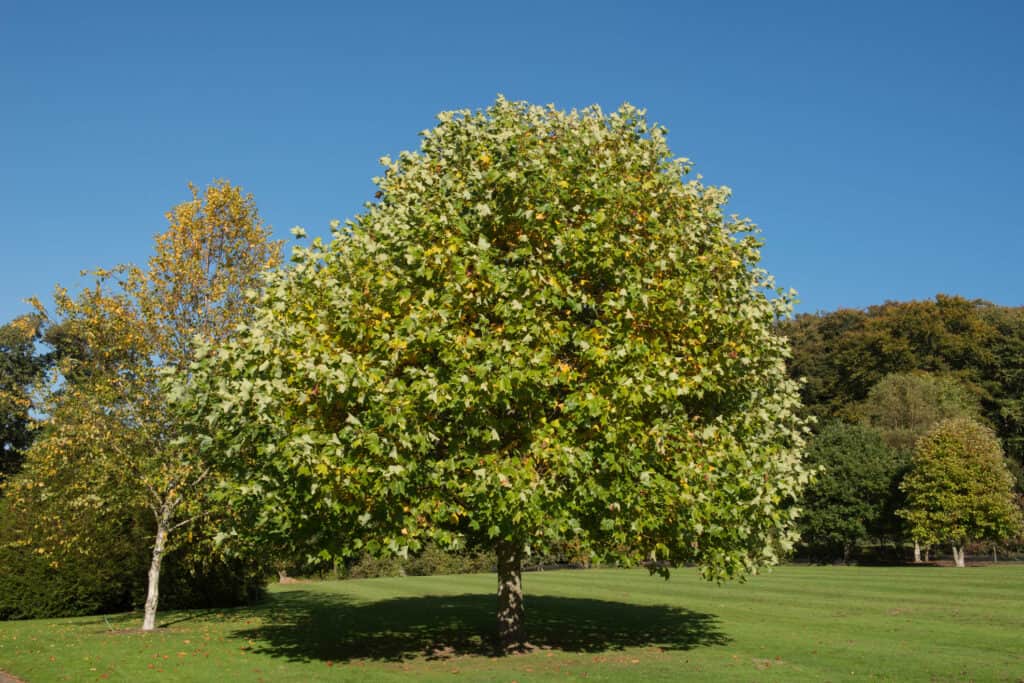
The Tulip Poplar, or
Liriodendron tulipifera, is a deciduous tree that is native to Kentucky.
©iStock.com/pcturner71
2. Oak
Oak trees are an important part of Kentucky’s native tree population, with ten varieties thriving in the state. These trees have a multitude of benefits for wildlife, including providing shelter and food through their acorns and other nuts. Additionally, oak trees provide homes for birds to nest in and can even create microclimates that support more diverse species of animals. The deep roots also help prevent erosion, which is essential for preserving the habitats of these creatures. Finally, oaks are known for their beautiful fall foliage – adding vibrant colors to any landscape during the autumn months!
- Black Oak – Grows in poor dry soils. 50-60 feet tall. The fall color is orange-brown or brown-red.
- Bur Oak – Slow-grower. Reaches 70-80 feet tall. The fall color is yellow.
- Chestnut Oak – Fast-grower. Reaches 60-70 feet tall. The fall color is yellow and orange.
- Chinkapin Oak – Reaches 40-80 feet tall with an equally wide canopy. The fall color is yellow-brown.
- Northern Red Oak – Fast-grower. Reaches 60-75 feet tall. The fall color is red.
- Pin Oak – Pyramidal shape. Reaches 60-70 feet tall. The fall color is bronze and red.
- Scarlet Oak – Rounded crown. Grows to 70-75 feet tall. The fall color is red.
- Shingle Oak – Slow grower. Reaches 50-60 feet tall. The fall color is yellow-brown and red-brown.
- White Oak – Crown equal to height, reaches 50-80 feet tall. The fall color is rich red.
- Willow Oak – Fast grower. Reaches 40-60 feet tall. The fall color is red.
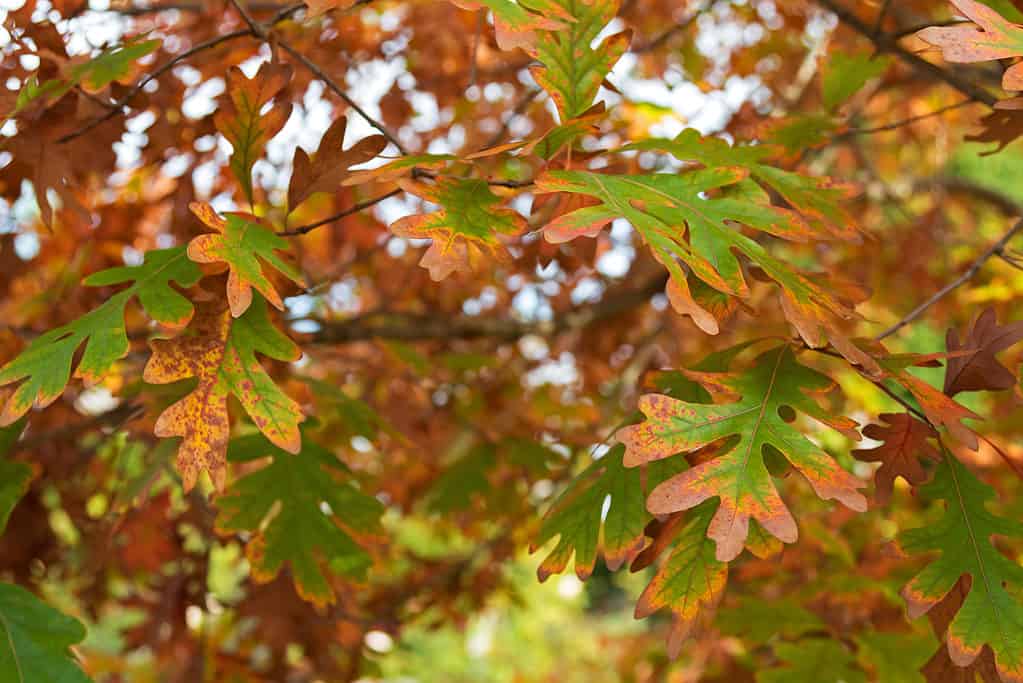
White oak trees are native Kentucky trees.
©sasimoto/Shutterstock.com
3. American Holly
American Holly (Ilex opaca) is a majestic evergreen tree native to Kentucky. It reaches 40-50 feet tall and features a pyramidal shape when fully grown. The tree prefers moist, acidic soil and offers clusters of bright red berries that last throughout the fall and winter months. This fruit benefits wildlife, such as birds, who feed on its sweet berries when everything else is covered in snow. American Holly also provides nesting sites for creatures in its dense foliage.
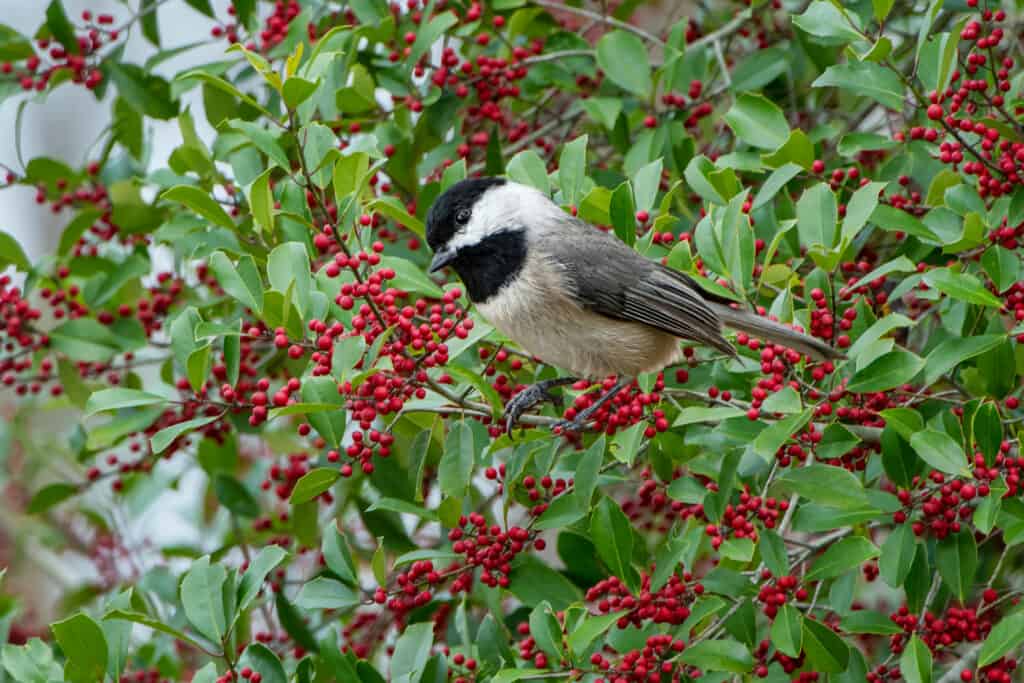
The American holly is a species of holly native to the eastern and south-central United States, including Kentucky.
©Bonnie Taylor Barry/Shutterstock.com
4. Kentucky Coffeetree
The Kentucky coffeetree has a rich history in the Bluegrass State, as it was once designated as the official state tree. It is found throughout Kentucky, usually inhabiting open woods and other sunny areas. As its name suggests, Kentucky coffeetree played an important role for early settlers who used its seeds to make a coffee-like beverage when regular coffee was unavailable.
The Kentucky coffeetree is a unique tree species easily identified by its large woody pods and exceptionally large leaves made up of smaller leaflets. Its bold form with contorted branching, distinctive bark, and decorative clusters of pods make it an ideal winter ornamental that stands out in any landscape design.

The Kentucky Coffeetree was at one time the official state tree. Now, it’s the Tulip Tree.
©Vipul1989/Shutterstock.com
5. Bald Cypress
Bald Cypress (Taxodium distichum) is a unique tree native to Kentucky that grows 50-70 feet tall with an attractive pyramidal shape. In summer, the vibrant, soft-looking needles are a stunning contrast against its shaggy cinnamon-colored bark. During fall, the foliage turns bronze or scarlet and falls from the tree to form a carpet of needles below. The bark peels off in long strips and is especially visible in winter when the tree has shed all its leaves. This deciduous conifer produces very popular cones among local wildlife for their high nutritional value. Bald Cypress makes an excellent ornamental addition to any garden or landscape design due to its beauty throughout every season of the year!
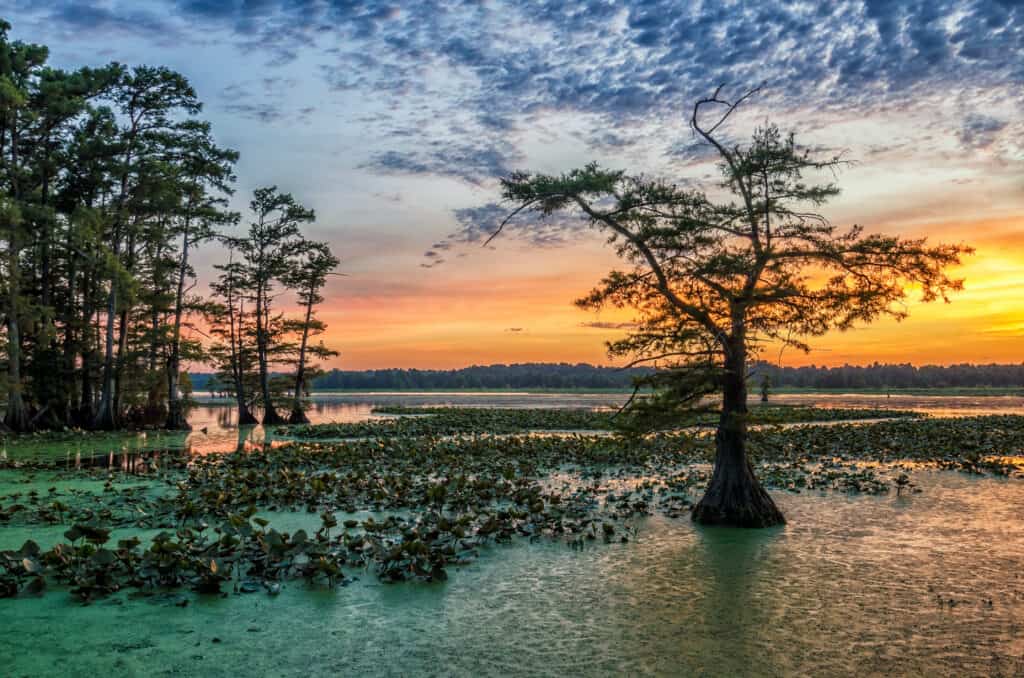
The Bald Cypress can grow up to 70 feet tall.
©anthony heflin/Shutterstock.com
6. Black Cherry
Black Cherry (Prunus serotina) is a tree native to Kentucky that grows 50-60 feet tall. It flowers in May with white blossoms and produces black-red berries in August and September. The wood from this tree is highly sought after by furniture makers due to its unique grain patterns and strength.
This species of cherry prefers moist, deep soil but will tolerate drier conditions. It greatly benefits wildlife by providing food for birds, mammals, butterflies, moths, and other insects. Additionally, the dense foliage blocks harsh winds while providing nesting material for small animals such as chipmunks or squirrels.

The Black Cherry tree provides a sought-after wood that is used to create solid, durable furniture.
©iStock.com/TeleMakro Fotografie (Ina Hensel)
7. Sourwood
The Sourwood tree is native to Kentucky and is a sight to behold in all four seasons. The summer blooms of Sourwood are especially beautiful; the flowers hang upside down from the branches, releasing a lovely fragrance into the air. In the fall, these trees turn a brilliant reddish-purple hue as their leaves change color with the season. Even after these leaves have fallen off for winter, you can still enjoy this magnificent species – its fruit capsules remain on the tree all winter long, creating a lovely display. Finally, in springtime comes new growth of bright green buds and leaves that bring the hope of warmer weather ahead! Not only is it visually pleasing, but also beneficial to bees – they rely on this species for pollen and nectar during their busy season!
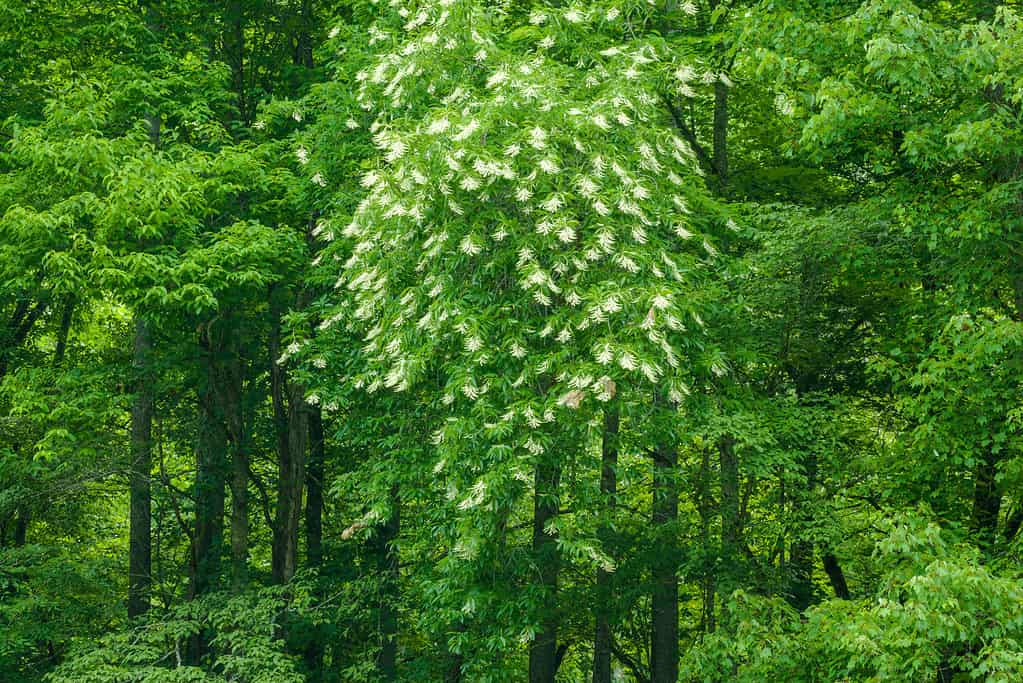
The blooms of the Sourwood tree hang upside down and provide a brilliant contrast against the green leaves.
©Jerry Whaley/Shutterstock.com
8. Yellowwood
Yellowwood is an impressive tree that can be spotted throughout Eastern Kentucky, but it is most abundant along the Kentucky River palisades in the Bluegrass region. During the spring season, this deciduous tree produces clusters of white flowers which hang 15 inches long and are quite fragrant. Some years offer a bonus of attractive yellow foliage during fall months, and its unique wintertime framework of branches adds another layer of interest to its beautiful landscape presence. Yellowwood grows between 30 – 50 feet tall with a spread up to 55 feet wide, making it a great choice for larger outdoor spaces.

The American yellowwood usually grows up to 49 feet tall, being a small to medium-sized tree.
©Peter Turner Photography/Shutterstock.com
9. PawPaw
Pawpaw is native to Kentucky and a mainstay of the eastern forest understory. Its semi-tropical appearance makes it stand out among its woodland neighbors, but what it’s really known for is its impressive fruit. The pawpaw berry can grow up to five inches long and provide invaluable sustenance for wildlife such as deer, birds, bears, raccoons, opossums, and squirrels. In order to thrive in Kentucky conditions, pawpaws require soil that is both slightly acidic and moist but not overly wet. It’s an important part of any healthy ecosystem in the Bluegrass State!
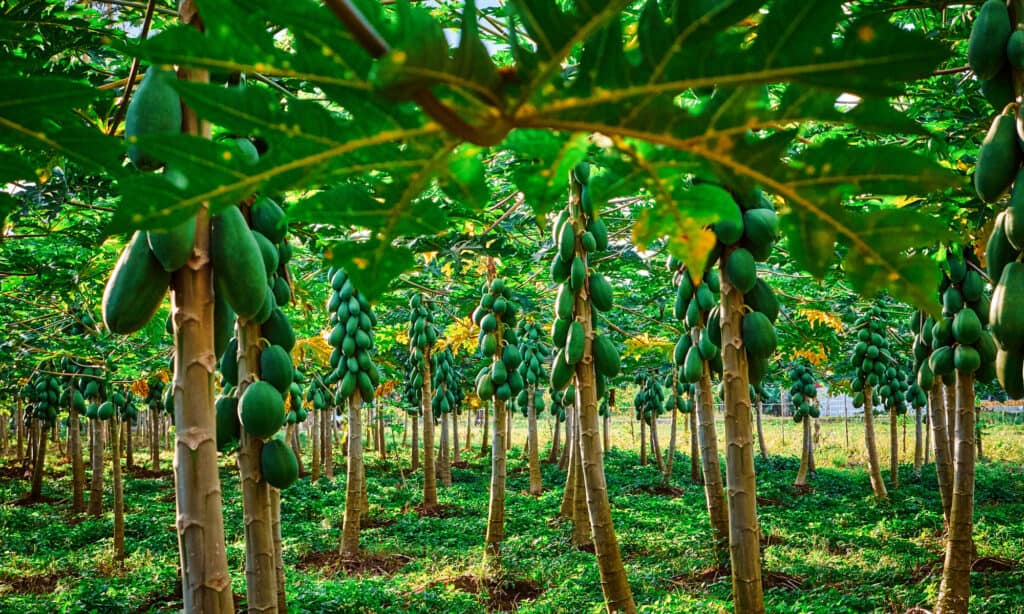
Pawpaw trees are known for the exotic fruit they produce.
©iStock.com/julien manigand
Summary of 9 Trees Native to Kentucky
| # | Tree | Fun Fact |
|---|---|---|
| 1 | Tulip Poplar | It’s the state tree of Kentucky! |
| 2 | Oak | Kentucky is home to 10 varieties of oak trees. |
| 3 | American Holly | Winter berries provide birds with sustenance during the winter. |
| 4 | Kentucky Coffeetree | Early settlers made a coffee-like beverage from its seeds. |
| 5 | Bald Cypress | This beautiful, deciduous conifer produces very nutritious cones for local wildlife. |
| 6 | Black Cherry | The wood from this tree is highly sought after for its beauty and strength. |
| 7 | Sourwood | Lovely white blooms hang upside down. |
| 8 | Yellowwood | Fragrant clusters of white flowers fill the air with perfume during the Spring. |
| 9 | PawPaw | Large pawpaw berries provide wildlife with invaluable sustenance. |
The photo featured at the top of this post is © iStock.com/julien manigand
Thank you for reading! Have some feedback for us? Contact the AZ Animals editorial team.






